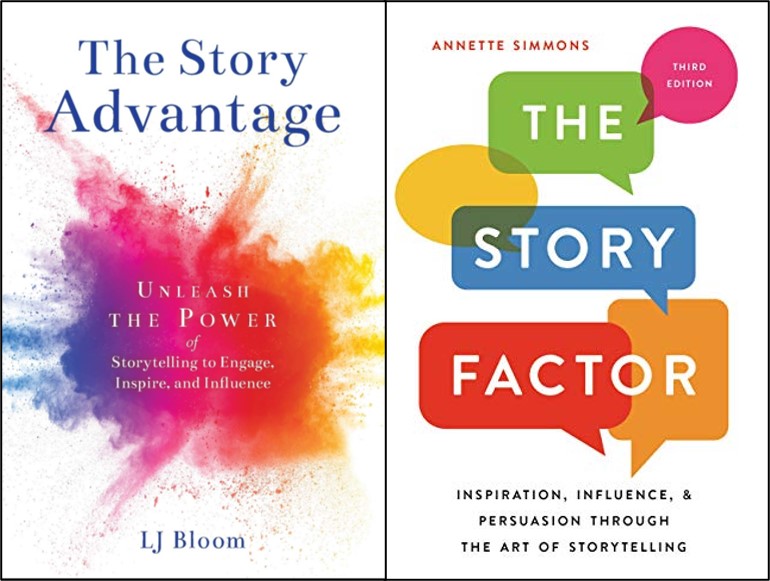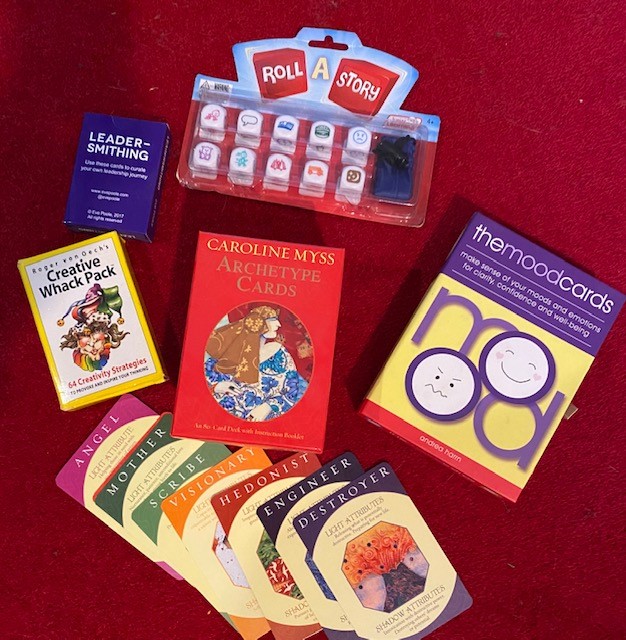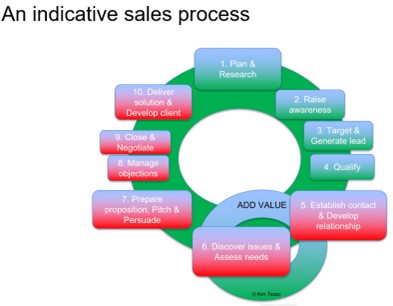
I’ve done lots of training and workshops on storytelling (see this 2017 summary of ideas on selling legal services with storytelling ). Often as part of persuasive writing sessions. The image below shows you some of the tools I use in my storytelling workshops. Most people know that research shows that stories are 22 times more likely to be remembered than facts and figures alone. Several people have asked me for book recommendations on storytelling. So here are two storytelling book reviews: The Story Advantage by LJ Bloom and The Story Factor by Annette Simmons.
The Story Advantage – Unleash the power of storytelling to engage, inspire and influence by LJ Bloom
At 140 pages, this 2020 book is a relatively quick read. It’s organised into three parts:
- Understanding Story
- Crafting story
- Telling story
A story or folk tale from around the world starts each chapter – which is a good illustration of the use and power of stories.
Understanding story (30 pages)
The author explains the value of telling your own story in business as it engages people emotionally, inspires, influences and generates interest. So storytelling is a key tool for leaders and entrepreneurs. I liked the observation that whilst we are more digitally connected than any previous time in history we are experiencing “a pandemic of disconnection”.
There’s an explanation of the origin of storytelling in all cultures to create meaning, connect and to teach young people how to live and understand their place in the world. There’s an observation that all cultures tell similar stories and that stories are the natural fabric of our communication and connection. In business, we create organisational culture through the stories we tell.
There are lots of laudable but accepted ideas such as: “The buying and selling of products is relational, we need to develop trust”. This is illustrated with the impact of stories by Nelson Mandela, J K Rowling, Starbucks and Henry Ford.
There are mentions of the neuroscience findings about stories – neural coupling, empathic responses, oxytocin release, processing narrative and triggers of better self-awareness. I liked the idea of asking people “What’s your story?” when you first meet them. It made me ponder how I would respond if asked for mine. Storytelling, the author argues, is the antidote to the informational approach.
“The greatest stories are those that cause the audience to discover something in themselves or about themselves that they have never known or long forgotten”. The author observes that even our most personal moments have a universal theme. There’s a contemporary reference to the role of viral storytelling in the #metoo movement and other recent social movements.
Crafting story (50 pages)
I expected some guidance here on how to identify and shape great stories. It mentions the skill in converting ordinary occurrences into compelling stories but the offered guidelines are pretty much what we use in all writing workshops (see, for example my list of top tips for persuasive writing ):
- Understand your audience
- Get clear on your intention (Think, Feel, Do)
- Understand the outcomes (What transformation do you offer?)
- Define your message (One core message)
- Determine the resistance (Address distrust and money with promise and possibility) and embed it in the story
There’s good use of metaphor in the section on the golden thread of a story. The author explains that to create her business she was encouraged to write a story every week in a blog by noticing what happens around her – stories are hidden in lived experience. You need to focus on finding pivotal moments by looking at patterns and connections.
The author uses a story about her father to show that the hero is never the storyteller – it is always the audience. From page 63 the content starts to feel more practical. The author says “Story is when something happens, (to someone) and it is described vividly and with emotion”. And there’s an interesting illustration of the difference between telling a story and trying to tell about a story.
Gustav Freytag’s pyramid structure is explained:
- Exposition
- Rising action
- Climax
- Falling action
- Denouement
The Story Spine from Pixar is illustrated:
- Once upon a time
- Every day
- Until one day
- Because of that
- Because of that
- Because of that
- Until finally
- And ever since then
- The moral of the story is
The narrative arc is mentioned – and the idea that it is not possible to conceive of a story without conflict. “The role of conflict in stories is to provide that catalyst through which our protagonist learns the required lesson and prove themselves worthy, by finding the creative and often unexpected resolution”.
The two aspects of character in stories are considered – archetypes and stereotypes. To make the story vivid use imagery, visualisation and sensory references. There are short sections on anchoring stories in time and space. And the power of secrets, discovery and humour (there’s an interesting comment that humour is not just about entertainment but allows us to deal with difficult or stressful situations). Humour often involves the violation of expectations and the contradiction of our perceptions of how things are meant to be.
(On writing humour, you may find this review of a comedy writing workshop and book from 2016 interesting)
Telling story (50 pages)
The author explains the intonation and attitude of the storyteller is “a kind of seduction”. There are some tips on preparing yourself to tell stories and preparing your space (your industry, your role and your physical space).
The story skeleton (a list of the key points to convey) is suggested to trace the movement and action of the story. And a suggestion that you map your story space by “walking into it”.
On language it talks about Non-Verbal Communication fundamentals – body movement (posture and gesture, your attire and facial expressions), the voice as well as the actual words. There’s a process offered to overcome stage fright (physical, intellectual, emotional and spiritual).
The book ends with the idea that every story involves some sort of journey. And a reminder that all stories exist within a certain culture. The author describes the magic triangle of story, storyteller and listener and maps Aristotle’s ethos, pathos and logos onto the storyteller, audience and message (I’d always seen his ideas as credibility, emotion and logic).
To be honest, I was a little underwhelmed with the book but then maybe I am not the target audience. At times, it feels a bit self-promotional as there are many references to the author’s work as a storytelling coach and speaker. But it’s a quick introduction to those who are unfamiliar with storytelling. And it pointed me in the direction of the second book I reviewed.
The Story Factor – Inspiration, Influence and persuasion through the art of storytelling by Annette Simmons
This 2019 book (now in its third edition) is a more substantial read at 320 pages in 12 chapters:
- The six stories you need to know how to tell
- What is story?
- What story can do that facts can’t
- How to tell a good story
- The psychology of story’s influence
- Sound bite or epic?
- Influencing the unwilling, unconcerned or unmotivated
- Storytelling as a tool of influence
- Storyteller dos and don’ts
- The life of a storyteller
- The twin powers of storytelling and technology
- The morals of our stories
The first 100 pages explain the power of stories in different situations such as sharing leadership’s vision, promoting organisational change and gaining employee engagement and buy-in. The focus is on using stories to influence and persuade. Story is defined as: “A narrative account of a significant emotional event or events that demonstrate relational truths”.
The author argues that the power of storytelling is in building trust and inspiring people to believe and have faith. Stories spark curiosity and create meaning. Storytelling is a pull rather than a push approach – the “show don’t tell” of persuasion. There’s reference to the value of self-disclosure and vulnerability when telling stories.
The author makes some great comments such as:
- “Explaining storytelling is like explaining a kitten”
- “This book provides your rational left brain with enough structure so it will relax a bit. However, most of this book speaks to your right brain”
- “In order to learn about influence, we must leave the comfort of models, linear sequences and step-by-step recipes. The magic of influence is less in what we say and more in how we say it and who we are”
- “We don’t want more information. We need to know what it means. We need a story that explains what it means and makes us feel like we fit in there somewhere”.
There’s an overview of the six types of stories that will serve you in influencing:
- Who I am?
- Why am I here?
- The vision
- Teaching (for developing new skills)
- Values in action
- I know what you are thinking
“People are not rational” starts a section on the importance of emotions. A message that pervades much of my work. In “how to tell a good story” the author explores: communications, authenticity, congruence and curiosity. Then there’s material on the importance of non-verbal communication (NVC) to engage all the senses and simulate the experience. “The psychological goal of influence is to connect your goals to your listeners self-interest in some manner”
“A storytelling lawyer activates the emotions and sense of a jury and invokes the power of drama to influence the decision”. Give people permission to show their emotions by showing your emotions as you tell your own stories.
The author argues that before you can influence you must establish some connection. And people listening to stories recognises our shared humanity. Genuine influence occurs between people who feel comfortable with each other. There’s a bold claim that regardless of our differences – money, status, race, gender, experience, culture – as human beings these common understandings flow beneath our superficial differences. “The more specific the story, the more universal the connections”.
Presentation skills of timing, pause, pace and tone are described. “Story has a graciousness that bypasses power struggles” leads into an analogy of the martial art of Aikido.
There’s a warning that to change a diametrically opposed opinion demands that you move in baby steps. Changing someone’s opinion or behaviour in gentle, gradual steps avoids resistance (see this article on resistance to change). There was a nugget on identifying stories here: review the personal experiences that brought you to the place where you now want to influence others.
There’s an examination of hypnosis and trance in storytelling (see Joe Vitale’s book on hypnotic writing). Listening to stories puts us in a young state of awareness that is less analytical, more receptive and better connected to hear unconscious thoughts and use imagination. The author suggests that listening to an engaging story lowers blood pressure and slows the heart rate.
There’s evidence that we are hardwired to monitor the balance between give and take. And that we all have vivid memories of injustice. Getting to yes too fast only creates the temporary illusion of successful influence. Human behaviour is influenced over time. “You have to tell your tribe the stories that changed your perspective so they can change their perspective as well”.
Avoid labelling those you want to persuade and see stories as a way to start bridging the gap. Six negative emotions (Cynical, Resentful, Jealous, Hopeless, Apathetic, Greedy) you might encounter are described with insights in how to deal with them.
Listening to stories is also shown to be a tool of influence – with echoes of counselling skills and guidance on creating a safe place. You need to empty out old stories before you can fill with new ones. Allowing others a verbal download helps builds our empathy. “The telling and hearing of stories is a bonding ritual that breaks through illusions of separateness and activates a deep sense of our collective interdependence”.
“The unquestioned desire for speed has created social patterns that multiply resentments in a disconnecting spiral of “I’m not getting attention so why should I give you attention?”” There’s a controversial argument that we should stop wasting time trying to create measurable outcomes to justify everything.
While referring to vision stories: “Only stories and metaphors can represent nonrational (emotional) relationships between people, between people and ideas, people and problems and all of the above. Rules oversimplify whereas stories mirror complexity”. She argues that Knowledge Managers know the value of storytelling to capture and share implicit wisdom that cannot be reduced to a spreadsheet. The intelligence that is labelled “tacit knowledge” is the wisdom hidden within stories that record the experiences of real people in real situations. Stories capture and keep culture.
In “storyteller dos and don’ts” there is mention of the shadow side of stories (e.g. Hitler’s use of stories) and the need for storytellers to use their power wisely and ethically. Amongst the dos: be authentic, intrigue, captivate and create hope. But avoid focusing on yourself as the hero, boring listeners, scaring people or making people feel guilty.
At page 264 there is more practical guidance. For example, Beverly Kane’s seven techniques for finding stories:
- Look for patterns
- Look for consequences
- Look for lessons
- Look for utility
- Look for vulnerability
- Look for future experiences
- Look for story recollections
A new definition of storytelling appears here: “Narration of a significant emotional experience that feels meaningful to both teller and listener”
Whilst warning that the use of story templates risks having all stories sound the same, she does share some:
- The hero’s journey (see my post on storytelling for details of the Hero’s Journey)
- “And, But, Therefore” – explaining that contrast is important in every story
- The Pixar story spine model (see above)
- Story as cause-effect, problem-solution or user experience
It’s an eloquent, engaging and persuasive book. It’s beautifully written – as you might expect from a storyteller. It draws on over 100 stories from around the world so it has universal appeal. The quiet authority and confidence of the author shines through. The book seems to cover a lot of ground but at the same time feels like there’s little substance to really get your head around – but I guess that’s the power of story: the experience. As a psychologist, it’s good to see the importance of emotions and empathy appear throughout the book. I was surprised to learn how many major events there are where people gather to tell stories and develop their art as storytellers.
Other resources
Another book on storytelling (in social media) I reviewed in 2012 “Mastering story” by Jay Oatway
These two books I also recommend for those interested in developing their writing skills:
- Book review – Peter Frederick’s “Persuasive writing” | Kim Tasso
- Book review by Kim Tasso – Ian Atkinson’s Business writing | Kim Tasso
Book review of Hypnotic writing by Joe Vitale | Kim Tasso is also an interesting read
There are many posts on writing as well, for example:
Business development writing for lawyers | Kim Tasso
selling legal services with storytelling | Kim Tasso
Top persuasive writing tips – Audience, structure and content | Kim Tasso
Persuasive writing – titles and tweets | Kim Tasso
persuasive writing – for business development | Kim Tasso
And some short explainer videos:
Seven secrets of business writing
The power of three in writing and presenting
Cialdini’s six principles of influence and persuasion








